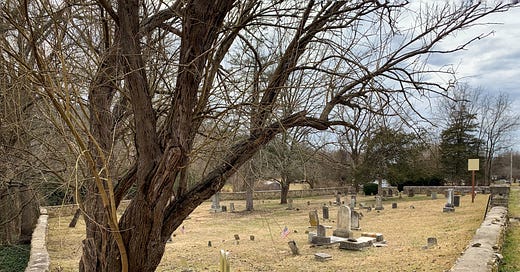Sunday Pastries With the Dead 16
The circa-1837 Finesville Union Cemetery in Finesville, NJ.
What I love about most super old towns is that they’re delightful little historical home-and-barn-laden blips along my country drives; what I loathe about them is that they’re almost always located on loud, crowded main roads (necessary lifelines to civilization back in the day; speeding car-covered scourges now). So there was—as the proverbial “they” say—“nothing ventured, nothing gained” when it came to this week’s graveyard locale, which was only accessible via a somewhat treacherous (but blessedly short) trek on the shoulder of one of those aforementioned busy streets.
Lucky for me, I know the owners of a gorgeous old set of barns-turned-antique shops just down the road, so I was able to park in their lot. I’m not sure what I would’ve done without that option—there’s no designated spot or shoulder at the cemetery. This is probably why, when I entered, the residents seemed to perk up—they definitely don’t get many visitors.
The town in which this petite 1837-era plot resides was established in 1751 as an iron forge along a river. In the late 1700s, two brothers bought the forge, built a dam, and expanded it into a grist mill, oil mill, and sawmill. In later years, the bustling settlement also boasted a paper mill and knife factory.
As is the case with almost every part of the New Jersey and Pennsylvania Delaware Valley, the town is also connected with George Washington. The forge made cannonballs for the Revolutionary War, and the cemetery sits on what was an original 600-acre parcel of land upon which 60 of the Continental Army’s cavalry horses were wintered in 1778.
George and Christopher Fine (above left), sons of one of the brothers who bought the original forge and expanded the town, reside here. John Hunt (above center), son of the 600-acre landowner, is buried here in a box tomb. And Christian Tomer (above right) is the father of William Gould Tomer, a well-known composer of Christian hymns including “God Be With You Till We Meet Again.”
My two favorite epitaphs were Libbie Babcock’s “Dying is but going home” and Mary Jane Bucknam’s total freakin’ mic drop of “She done what she could.”
I loved the varied symbols among the stones, as well. 10-month-old Hetty Hartman’s lily (above far left) means innocence and purity. The front stone of William Merritt’s collapsed cradle grave (above left center) shows a handshake that stands for marriage (he’s buried beside his wife). The Dalton family’s grand marker (above right center) is topped with an urn that represents the physical body’s dissolution as the soul ascends to heaven. Ann Broadhead’s leaves (above far right) left me a bit puzzled; they seem like a deconstructed version of either oak or olive leaves—the former symbolizes patience, faith, and strength; the latter, peace and humility.
To finish out the visit, let’s have a moment of appreciation for these truly inspired historical names (above left to right): Alburtis Laubach, Reuben Sinclair, Moses Hartman, and Mahlon Snider. Not pictured (her name is on a multi-sided memorial that I regrettably missed) is my favorite: Rosanna Sailor Bellis. Until next Sunday, fellow taphophiles!











as a fellow cemetery lover this is greatly appreciated ❤️ you're a beautiful writer